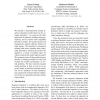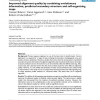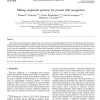62 search results - page 5 / 13 » CONTRAlign: Discriminative Training for Protein Sequence Ali... |
EMNLP
2007
13 years 8 months ago
2007
We describe a discriminatively trained sequence alignment model based on the averaged perceptron. In common with other approaches to sequence modeling using perceptrons, and in co...
ICASSP
2010
IEEE
13 years 5 months ago
2010
IEEE
We investigate incremental word learning with few training examples in a Hidden Markov Model (HMM) framework suitable for an interactive learning scenario with little prior knowle...
BMCBI
2006
13 years 6 months ago
2006
Background: Protein sequence alignment is one of the basic tools in bioinformatics. Correct alignments are required for a range of tasks including the derivation of phylogenetic t...
BMCBI
2010
13 years 6 months ago
2010
Background: The classification of protein sequences using string algorithms provides valuable insights for protein function prediction. Several methods, based on a variety of diff...
JBI
2008
13 years 6 months ago
2008
Protein data contain discriminative patterns that can be used in many beneficial applications if they are defined correctly. In this work sequential pattern mining (SPM) is utiliz...



